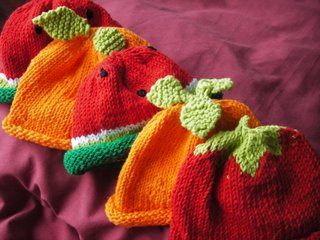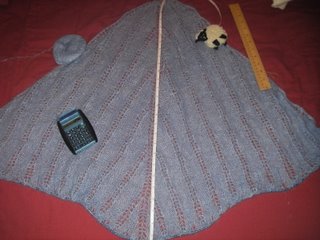
My genius of a brother has been visiting me for the last two weeks. He is wonderful with all smarty-pants stuff, like math, physics, computer science, etc. So I showed him my Icarus-Shawl-In-Progress, told him about my constant worry that I shall run out of yarn, and posed him the following questions:
Q1) Kel has only 3 skeins of yarn (she bought them up at a yarn store with no pattern in mind because she enjoyed feeling them up) of approximately 630 meters (3x210 meters each, according to the ball bands) for a pattern that requires 800 meters. Kel has assumed that her yarn will run out if she follows the pattern exactly. With that in mind, she has cut out 2 of the 5 repeats suggested in the pattern.
Will she run out of yarn?A1) Perhaps. Just from yardage (meterage?) Kel has 78% of the yarn used in the pattern. Are the two repeats enough to cut out this percentage? (This is further complicated by the magazine editors comments that the shawl only weighed 90 grams, which is 90% of the alpaca skein called for in the pattern, and
KAL bloggers comments that their shawls took
more than the amount called for in the pattern!)
Q2) I am using the
shawl percentage calculator found on Rose-Kim-Knits to hopefully determine the percentage of yarn used. However, this MS Excel spreadsheet is an area calculation of a triangle if one begins at either the base or the tip of the triangle and works straight rows to the other side. This calculator, when adjusted for the 196 rows I am now knitting (after cutting out 2 pattern repeats) reports that after one skein I have used 32.1% of my yarn.
Will I run out of yarn?A2) Perhaps. This pattern is not a tip-up or base-down pattern, but a steadily increasing triangle: we increase along all edges of the pattern at once. Therefore, we need to do an area calculation for the triangle based on the gauge we have already achieved, and the pattern's gauge and finished dimensions. We know that the pattern is supposed to be 36 inches base-to-tip and 72 inches across the base. Repositioned into a square, this gives us an end area of 1296 square inches (or 36"x36") over 244 rows using a gauge of 9.5 rows and 5.25 stitches per inch. My gauge is 6 rows and 4.5 stitches per inch, over 196 rows. The first skein of yarn created a triangle measuring 25 x 25, and completed 111 of the 196 rows. Assuming that I will use all three skeins of yarn, and each skein will be 33.3% of the total area of the shawl, then my completed 111 rows will be one-third the total area.
Q3) But wait! This assumes an even pattern, like an even stockinette or something. This pattern begins quite standard, with mostly stockinette with an increase of 4 stitches every-other-row, and a few K2Tog and YO for the stripey ribs. Then all hell breaks loose at the end of the pattern as we create holey, lacey feather looking things. Apparently, the holier the lace, the less yarn we use. So won't we actually gain some leeway in the lacey bits? Does that mean that being short 1.2% on the first skein (33.3% minus 32.1% per shawl-percentage-calculator) will be made back in the lacey bits?
You mean I won't run out of yarn?A3) Perhaps. So people on the KAL have reported that holey lacey bits take less yarn than the basic stockinette at the beginning of the pattern. Can they tell you how much less? (um. no.) What is that percentage? Say it is 50% less yarn for lace than stockinette (I know: It couldn't possibly be that much less, but it makes an easy number). We need to assign the volume of yarn needed to complete the first stockinette area as "thickness 1" and the volume of yarn needed to complete the lacey part as 50% of that thickness, or "thickness .5". We then do the same area calculations above, only realizing that the amount of yarn in the lace will be less by this percentage. However, we still don't know the percentage of yarn used for lace as opposed to the percentage of yarn used for stockinette, so we can't complete this calculation.
Q4) Furthermore, Skein #2 seems to be about half stockinette pattern and half chart 2, which is the beginning of the lacey bits. Therefore, skein#3 will be entirely lacey bits. We thus have to do the above calculations while splitting skein# 2 into half "thickness 1" and half "thickness .5"...
A4) Right. But since we still don't know the exact ratio of yarn usage for lace vs. stockinette, we still don't know the value.
Q5) Assuming I will run out of yarn, I have also switched from the size 3 needle suggested in the pattern to a size 5 needle, on the hopes that a looser, holier knit will give me a large-sized shawl while using less yarn. Knitters often adjust their gauges by trading up or down on their needle size, and since I am a tight knitter, I often go up a few needle sizes to compensate anyway.
Will I still run out of yarn?A5) Do you know what fractals are? (Um. No. Well, kinda, since I just read about the Coastline skirt in
Knitting Nature: 39 Designs Inspired by Patterns in Nature by Norah Gaughan.) This is pretty advanced math, but apparently brilliant math-geeks like my brother can figure out the distance of yarn needed to complete the same pattern over a size 3 needle versus a size 5 needle. This blew my mind. However, with the Icarus pattern in general, we still have the same gaps of information (What percentage am I cutting out by not repeating 5 times? What is the ratio between yarn used for stockinette versus an inconsistent lace pattern?) I hope for a more advanced math lesson in fractals, and watch this space for me measuring the circumference of needles and the distance of yarn needed to complete one stitch. I am enthralled!
So, after all of that math, I am no closer to the truth of my yarn usage than I was at the beginning. I shall still continue to knit away and worry and hope, and the yarn will be what the yarn will be. However, he has given me hope that the three steps I have taken:
1) larger needles.
2) cut out repeats #4 and 5
3) Lacey bits will take less yarn than stockinette
Will hopefully yield a large, lacey shawl with perhaps a bit of yarn left over.
(um. You think if I have a bunch of yarn leftover I will be tempted to rip it back and put the repeats back in? I may need some help with the math...)
Update: After an exhausting day of diving, I reported that I was going home to measure my knitting before crashing into bed. You know what he did? He called
me a
nerd! Ah well. I am thankful I have such a brilliant and cool brother, and shall wear the mantle of "nerd" as proudly as if I had knitted it myself!
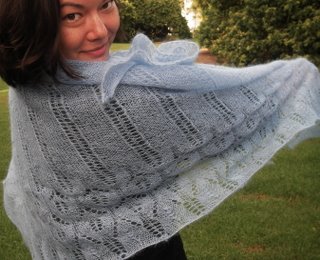 Icarus Shawl from Interweave Magazine, Summer 2006.
Icarus Shawl from Interweave Magazine, Summer 2006.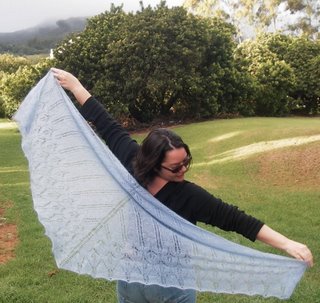 Yarn: Rowan Kidsilk Haze. 3 skeins. All of three skeins! 75 grams, 630 meters/687 yards. Shade 592 light blue.
Yarn: Rowan Kidsilk Haze. 3 skeins. All of three skeins! 75 grams, 630 meters/687 yards. Shade 592 light blue.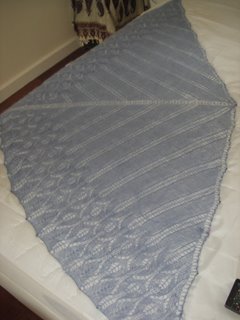 Pattern Alterations: Only 3 repeats of chart one instead of 5 repeats called for in the pattern. I had calculated correctly that I did not have enough yarn and had no way of getting more. Ended up with a very tight cast off, and then an even tighter final crochet-style bind off in the last third of the pattern. Seriously: Ran out of yarn. Due to the tight bind off, I have more of a scalloped edge than the pretty, extreme feathery points shown in the magazine. Oh well, nothing to be done!
Pattern Alterations: Only 3 repeats of chart one instead of 5 repeats called for in the pattern. I had calculated correctly that I did not have enough yarn and had no way of getting more. Ended up with a very tight cast off, and then an even tighter final crochet-style bind off in the last third of the pattern. Seriously: Ran out of yarn. Due to the tight bind off, I have more of a scalloped edge than the pretty, extreme feathery points shown in the magazine. Oh well, nothing to be done!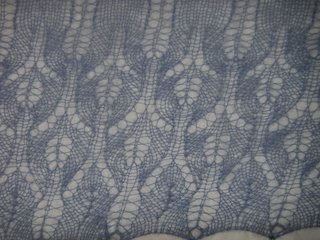 Shetland weight: I did actually pass this entire shawl through a ring!
Shetland weight: I did actually pass this entire shawl through a ring!

